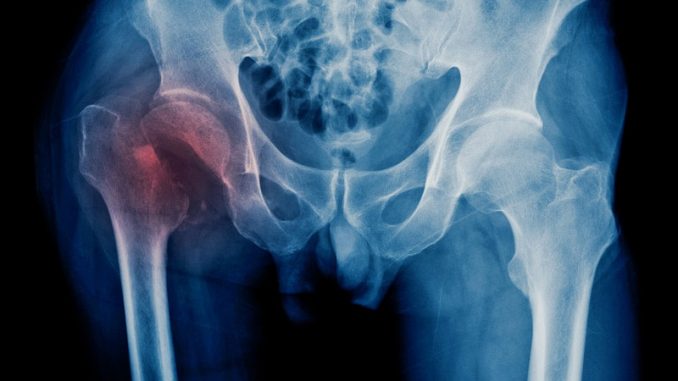
Patients with dementia are six times more likely to die after sustaining a hip fracture than are those without dementia, new research shows.
Preliminary results from a registry-based study also showed that the percentage of participants who could not walk 4 months after a hip operation was almost double for those with dementia than it was for those without dementia.

Dorota Religa, MD, PhD
The findings underscore the importance of discussing medications that increase risk for a fall — and an ensuing hip fracture — at the time of a dementia diagnosis, co-investigator Dorota Religa, MD, PhD, professor and consultant in neurogeriatrics, Karolinska Institutet, Stockholm, Sweden, told Medscape Medical News.
Along with other healthcare professionals, such as geriatricians, internal medicine specialists, orthopedic surgeons, and rehabilitation experts, neurologists are an integral part of the team managing patients with dementia, she noted.
“This is a chain, and every piece of this chain should work properly for people with dementia,” Religa said.
The findings were presented at the Congress of the European Academy of Neurology (EAN) 2022.
Worse Mobility, Greater Mortality
Risk for both hip fractures and dementia increases with age. As the population gets older, the negative impact of these two conditions on quality of life is also likely to increase.
Past research has shown patients with dementia fare worse after a hip fracture than do those who are cognitively intact, but it has been unclear as to what extent.
The current investigators tapped into both the Swedish National Hip Fracture Registry (RIKSHÖFT) and the Swedish registry for cognitive/dementia disorders (SveDem). Accessing data on patients with dementia from such registries is important because these individuals are often excluded from clinical trials, said Religa.
The study included 122,614 participants with a first hip fracture that occurred between 2010 and 2018.
Patients with dementia had a mean age of 84 years, which was about 2.9 years older than those without dementia (P < .001). They also had more comorbidities, said Religa.
In addition, those with dementia had worse mobility at the time of their fracture than did those without dementia. For example, 28.5% could walk alone outdoors compared with 63.5% of their peers without dementia. In addition, 3.2% vs 2.8%, respectively, could not walk at all.
The dementia group also had a higher rate of in-hospital mortality (3.7% vs 3.4%; P < .001).
Mobility at the 4-month follow-up painted a similar picture of disparity. Among those with dementia, 8.8% could walk alone outside vs 42.3% of those without dementia; 20.7% vs 10.5% could not walk at all.
Moreover, the dementia group had a significantly higher likelihood for mortality at 4 months (odds ratio, 6.3; P < .001).
Patient, Family Discussions Are Crucial
Although the researchers expected the patients with dementia to have worse outcomes after a hip fracture, the extent to which they lagged behind those without dementia was surprising, Religa said.
It is not clear what factors contributed to these relatively poor outcomes. Religa said that the investigators are now delving deeper into the data to uncover possible explanations. For example, they plan to investigate whether the type of dementia, such as frontal lobe dementia, may play a role.
They also want to assess risk for a second hip fracture in those with dementia.
For now, when an individual is diagnosed with dementia, the clinician should discuss with that patient and their family how to minimize risks for falls, said Religa.
In addition, “this might be a good time to discuss what medications the patient is taking,” she said.
For example, a patient taking an antipsychotic may no longer be benefiting from the medication, she added.
Religa referred to a 2020 EAN guideline on medical management issues in dementia. It recommended that those with dementia and agitation or aggression be treated with atypical antipsychotics only after all nonpharmacologic measures have been proven to be without benefit.
Patients with dementia who suffer a hip fracture may also need a more tailored approach to rehabilitation, said Religa. She noted that these patients may be confused and refuse home therapy (a relatively new rehabilitation setting in Sweden) when a physiotherapist arrives at their door.
“They may need a little bit of special treatment,” said Religa. Perhaps the physiotherapist could “try again in 5 minutes,” she added.
Illustrates Patient Vulnerability
The study was included in the dementia highlights session of the EAN meeting. The highlights were presented by Kristian Steen Frederiksen, MD, PhD, consultant neurologist and researcher, Danish Dementia Research Centre at Rigshospitalet, University of Copenhagen, Denmark.
Frederiksen told Medscape Medical News that the use of large nation-wide registries adds weight to the findings.
The study also illustrates the “vulnerability” of patients with dementia, he said. Frederiksen agreed with the investigators that it is unclear what factors contribute to this vulnerability but noted that many patients with dementia have comorbidities.
It is also not known if interventions, such as postfracture rehabilitation, that are designed specifically for patients with dementia would improve outcomes, he said, adding that further research is needed.
The study was supported by a Stockholm University–Region Stockholm grant and the Swedish Research Council. The investigators and Frederiksen have reported no relevant financial relationships.
Congress of the European Academy of Neurology (EAN) 2022. Abstract A-22-04968. Presented June 27, 2022.
For more Medscape Neurology news, join us on Facebook and Twitter
Follow Medscape on Facebook, Twitter, Instagram, and YouTube
Source: Read Full Article